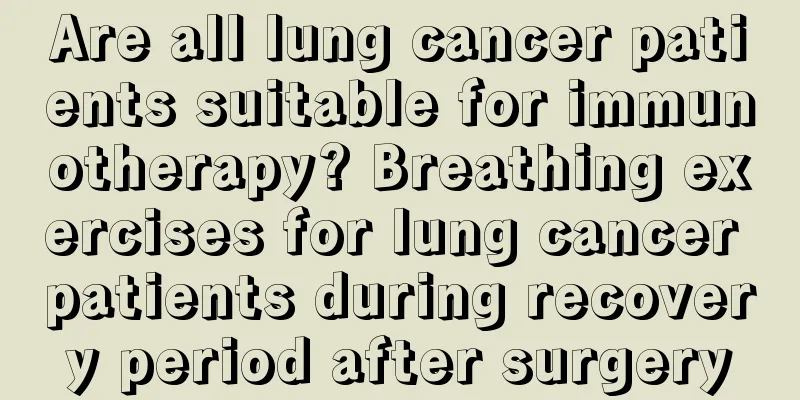Are all lung cancer patients suitable for immunotherapy? Breathing exercises for lung cancer patients during recovery period after surgery

|
Breathing exercises for lung cancer patients during recovery period after surgery Surgery is the first choice for treating lung cancer. It often requires the removal of part or all of one side of the lung tissue, and respiratory function is impaired to varying degrees. To improve the patient's quality of life, breathing exercises can be started after the condition stabilizes. 1. Breathe through your nose: Inhale through your nose and exhale slowly within 4 to 6 seconds. Do this 3 to 5 times a day, 5 to 10 times each time. 2. Raise your arms and breathe: inhale when you raise your arms outward, and exhale when you lower them. Let your arms hang naturally on both sides of your body, and move them up and down alternately along the sides of your body, inhale when you move up, and exhale when you return to the original position. 3. Abdominal breathing: The abdomen bulges when inhaling and slowly retracts when exhaling to reduce irritation to the chest surgical incision. 4. Chest breathing: The chest rises when inhaling and relaxes when exhaling. The rhythmic expansion and relaxation of the chest improves blood circulation, prevents tissue adhesion and tightening of wound skin, and promotes wound healing. 5. Leg-lifting breathing: Stand with one hand supporting you, and bend and lift your lower limbs alternately. Inhale when you lift them, and exhale when you return them. First, take a deep breath through your nose, and purse your lips when you exhale, like whistling. 6. Diaphragm exercise: The patient lies on his back or sits, with both hands placed on the upper abdomen. When inhaling, the abdomen rises slowly, and both hands apply pressure to do resistance exercises. When exhaling, the abdomen sinks, and the hands sink with it. At the end of exhalation, slightly apply pressure to further raise the diaphragm. 7. Whole body training: 1 to 3 months after surgery, gradually increase whole body fitness training, such as walking, exercise bike, swimming, Tai Chi, yoga, etc., which will help improve respiratory function. Are all lung cancer patients suitable for immunotherapy? Lung cancer patients can receive immunotherapy. Different types of lung cancer patients have different treatment options. If there is no pDL1 in the body, immunotherapy will not be effective. If pDL1 in the body meets the standard, immunotherapy can be selected. For patients with severe conditions, chemotherapy is required as an auxiliary treatment. Nowadays, medical science is developing better and better. When you are sick, you can take reasonable measures to improve your condition and reduce the damage to your body. Lung cancer is a very dangerous disease. Once it is discovered, it must be treated in a targeted manner. Targeted and immunotherapy are the methods chosen by most patients. So are all lung cancer patients suitable for immunotherapy? Lung cancer does not necessarily require immunotherapy. Some patients are not suitable and need to decide based on their physical constitution. If there is no pDL1 in the body, it is because of the lack of new antigens, then perhaps the lung tumor has already had lesions. If this is the case, immunotherapy will not be effective and you need to choose medication for treatment. Some patients do not respond well to treatment and need to choose chemotherapy for treatment. If the pDL1 in the patient's body reaches the standard, immunotherapy can be chosen. Some patients have special components in their bodies and their bodies are in an unstable state, which may be due to factors such as gene mismatch. Immunotherapy can be used to repair the damaged nerves in the patient's body. The doctor needs to treat the patient according to the condition and choose the appropriate plan. Immunotherapy actually has side effects. A small number of patients will experience immune-related inflammatory manifestations, such as interstitial pneumonia and liver function. Therefore, during treatment, you need to listen to the doctor's advice and let the doctor give guidance and supervision to prevent the physical condition from becoming more serious. You must listen to the doctor's advice during treatment. Different treatments are chosen for different types of lung cancer. If you have lung cancer in the early stages, you can choose surgery. If it is found to be in the late stages, then surgery is not necessary. You need to use drugs to treat it, and then combine it with radiotherapy. If you are a non-small cell lung cancer patient and there is a mutation, you can take targeted drugs. Chemotherapy is more suitable for non-mutation patients. |
Recommend
What is the correct way to do prenatal education?
With the development of society, the level of edu...
What are the early signs of lung cancer? Detailed explanation of several early symptoms of lung cancer
Lung cancer is a serious disease for people. It w...
What are the effects and functions of horn combs
Many people think that an ox horn comb is just a ...
Is the cost of colon cancer surgery high?
Colon cancer is mostly caused by the malignant tr...
One side of the ear is blocked
Many nerves inside the ear are closely related to...
Can skin cancer be transmitted through the air?
In life, we often avoid people whose skin looks p...
Where should the clock be hung at home? Feng Shui is very important in the home
Feng Shui is very important in the home. Good Fen...
The difference between brown and black stool
There are always many patients suffering from gas...
Why does my left chest hurt?
If the left chest hurts, it is very likely a symp...
Is the white line on the shrimp head a parasite?
For a long time, there has been a rumor on the In...
Head sweating is cured
Head sweat actually refers to people with hyperhi...
What ointment to use for neck allergy
Everyone has some allergies to some extent. Gener...
Milk powder and milk
Milk powder and milk are the most common drinks u...
What are the benefits of maggot therapy?
Maggot therapy uses special medical maggots. Usin...
What are the plants that absorb formaldehyde
A new house must be occupied immediately after de...









